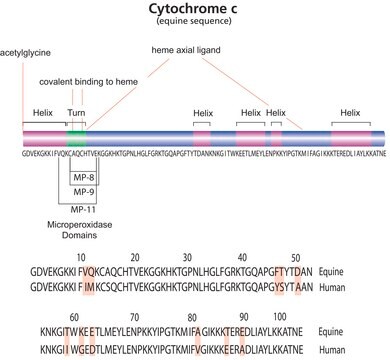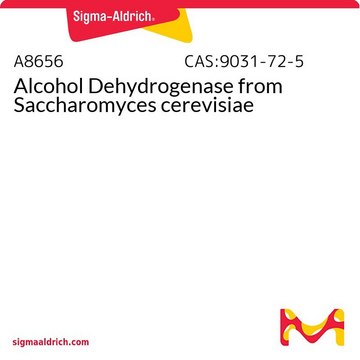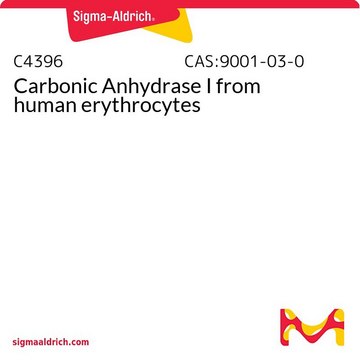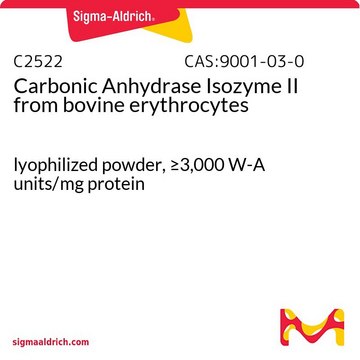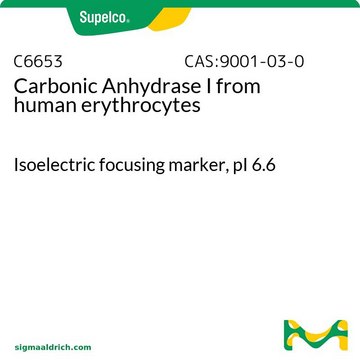C7025
Anidrasi carbonica
BioReagent, suitable for GFC marker
Sinonimo/i:
Carbonato deidratasi, Carbonato idrolasi
Autenticatiper visualizzare i prezzi riservati alla tua organizzazione & contrattuali
About This Item
Prodotti consigliati
Nome Commerciale
BioReagent
Livello qualitativo
Stato
powder
PM
~29,000
Confezionamento
vial of 15 mg
Compatibilità
suitable for GFC marker
Temperatura di conservazione
−20°C
Cerchi prodotti simili? Visita Guida al confronto tra prodotti
Applicazioni
Carbonic Anhydrase from bovine erythrocytes is a bioreagent used in gel filtration chromatography, protein chromatography and plasma and blood proteins. Carbonic anhydrase has been used to study compounds widely known to have anticancer properties against human cancers and that act as diuretic, antibacterial, antifungal, antitubercular and leishmanicidal agents.
Gel filtration molecular weight marker
Avvertenze
Danger
Indicazioni di pericolo
Consigli di prudenza
Classi di pericolo
Resp. Sens. 1
Codice della classe di stoccaggio
11 - Combustible Solids
Classe di pericolosità dell'acqua (WGK)
WGK 3
Punto d’infiammabilità (°F)
Not applicable
Punto d’infiammabilità (°C)
Not applicable
Dispositivi di protezione individuale
Eyeshields, Gloves, type N95 (US)
Scegli una delle versioni più recenti:
Possiedi già questo prodotto?
I documenti relativi ai prodotti acquistati recentemente sono disponibili nell’Archivio dei documenti.
I clienti hanno visto anche
Wisath Sae-Lee et al.
Cell reports, 40(3), 111103-111103 (2022-07-21)
Red blood cells (RBCs) (erythrocytes) are the simplest primary human cells, lacking nuclei and major organelles and instead employing about a thousand proteins to dynamically control cellular function and morphology in response to physiological cues. In this study, we define
Do Hyeon Kim et al.
Journal of microbiology and biotechnology, 30(12), 1905-1911 (2020-10-14)
Homoserine dehydrogenase (HSD) catalyzes the reversible conversion of L-aspartate-4- semialdehyde to L-homoserine in the aspartate pathway for the biosynthesis of lysine, methionine, threonine, and isoleucine. HSD has attracted great attention for medical and industrial purposes due to its recognized application
Leo Syrjänen et al.
Journal of medicinal chemistry, 56(18), 7372-7381 (2013-08-28)
Leishmaniasis is an infection provoked by protozoans belonging to the genus Leishmania. Among the many species and subsepecies of such protozoa, Leishmania donovani chagasi causes visceral leishmaniasis. A β-carbonic anhydrase (CA, EC 4.2.1.1) was cloned and characterized from this organism
Yanhong Pang et al.
The Journal of biological chemistry, 288(26), 19081-19089 (2013-05-16)
Domain V of the 23S/25S/28S rRNA of the large ribosomal subunit constitutes the active center for the protein folding activity of the ribosome (PFAR). Using in vitro transcribed domain V rRNAs from Escherichia coli and Saccharomyces cerevisiae as the folding
F E Lock et al.
Oncogene, 32(44), 5210-5219 (2012-12-05)
The sub-population of tumor cells termed 'cancer stem cells' (CSCs) possess the capability to generate tumors, undergo epithelial-mesenchymal transition (EMT) and are implicated in metastasis, making treatments to specifically target CSCs an attractive therapeutic strategy. Tumor hypoxia plays a key
Il team dei nostri ricercatori vanta grande esperienza in tutte le aree della ricerca quali Life Science, scienza dei materiali, sintesi chimica, cromatografia, discipline analitiche, ecc..
Contatta l'Assistenza Tecnica.


